#Native Application Development Pros
Explore tagged Tumblr posts
Text
#Benefits of Native Application Development#Native App Development Advantages#Why Choose Native App Development#Native vs Hybrid App Development#Advantages of Native Mobile Applications#Native App Development for iOS and Android#Native Mobile App Benefits#Native Application Development Pros#Performance Benefits of Native Apps#Why Build Native Mobile Applications
0 notes
Text
Ship Mobile Fast
Ship your AI apps in days, not weeks.
Save weeks of development time with our React Native Expo Boilerplate. In App Purchases, Open AI, Anthropic, Replicate, Fal AI, GlueStack, AI Proxy Backend, Firebase, Supabase, Admob, and more.
Ship Mobile Fast AI Wrapper is Live!🔥
For those who want to build AI applications…
Now, you can create the apps you envision in just 1-2 days.😎
Integrations with OpenAI, Anthropic, Replicate, and Fal AI. Protect your API keys from being stolen with AI Proxy Backend.
*
Pro (Best for Casual Apps):
In App Purchases (RevenueCat) Google Mobile Ads Authentication Flow Onboarding Flow Push Notifications Multi Language Support Error Tracking App/User Analytics Lifetime Updates Private Discord Channel Access Supabase⚡️ GlueStack Version StyleSheet Version
*
AI Wrapper (Best for AI Projects):
In App Purchases (RevenueCat) Google Mobile Ads Authentication Flow Onboarding Flow Push Notifications Multi Language Support Error Tracking App/User Analytics Lifetime Updates Private Discord Channel Access Firebase🔥 AI Proxy Backend (API Keys Secured🔒) Open AI & Anthropic Replicate AI & Fal AI Ready-to-Use AI Templates
*
Ship Mobile Fast: https://shipmobilefast.com/?aff=1nLNm
Telegram: ahmetmertugrul
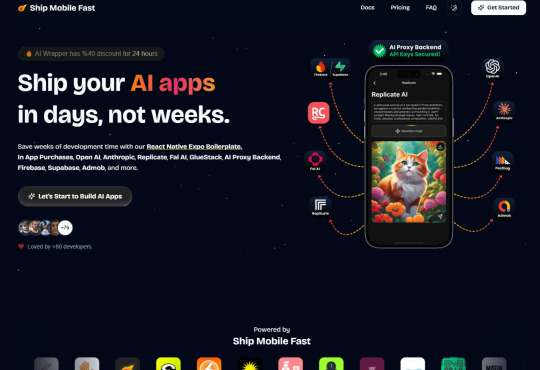
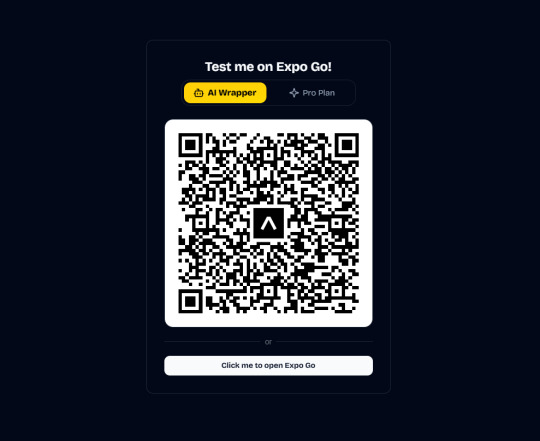
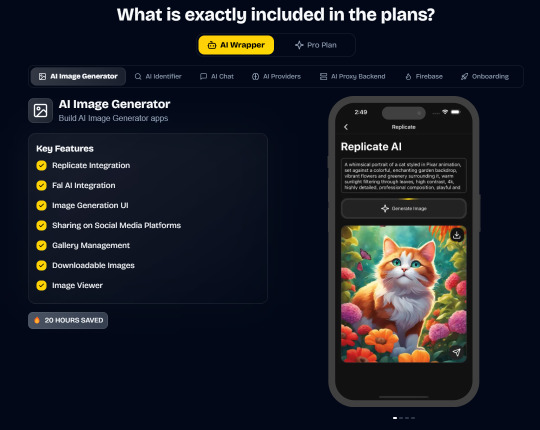
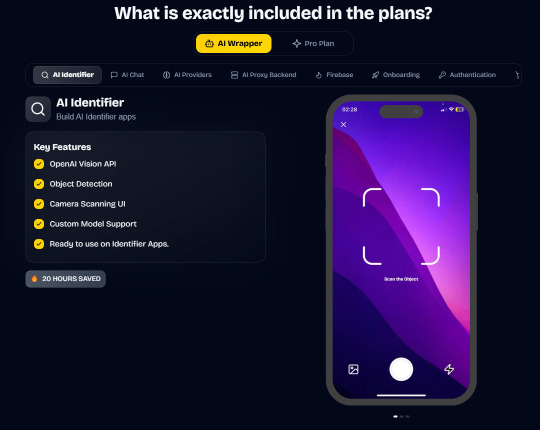
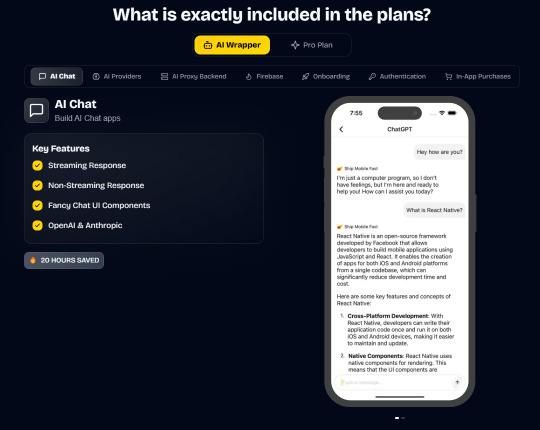
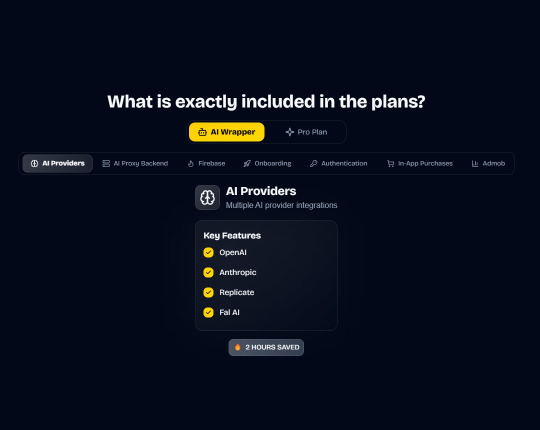
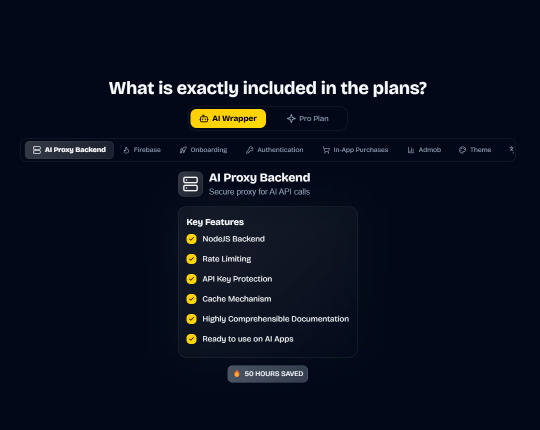
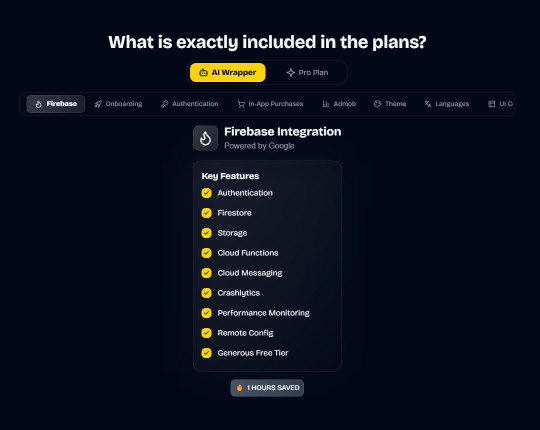
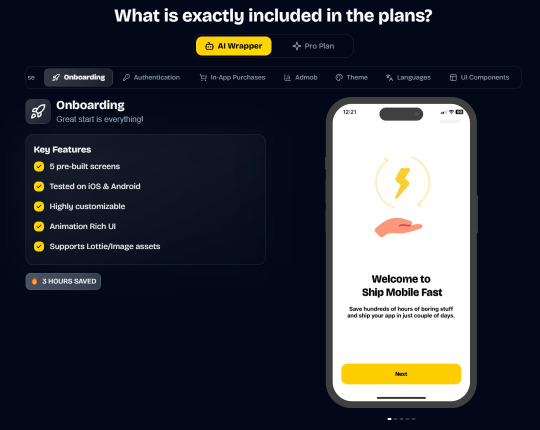


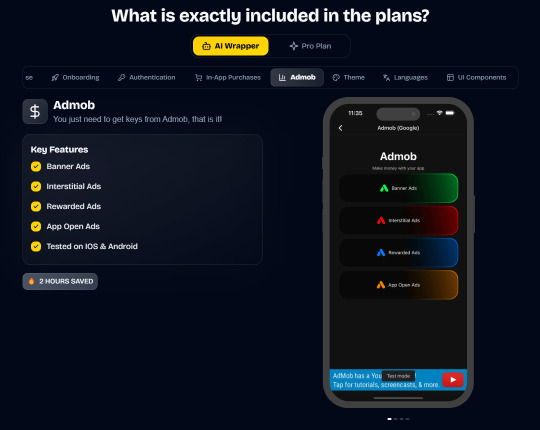
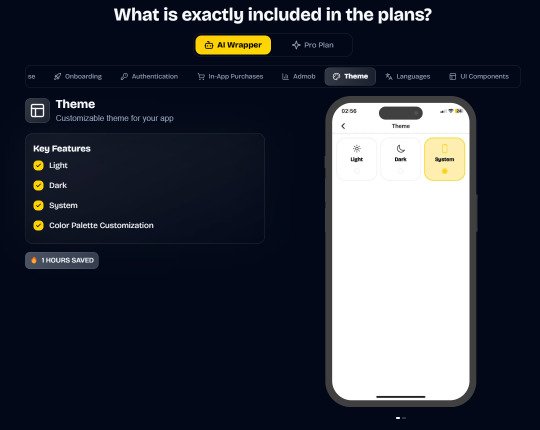
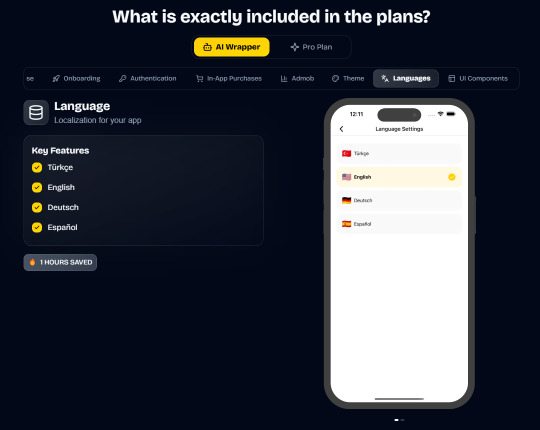
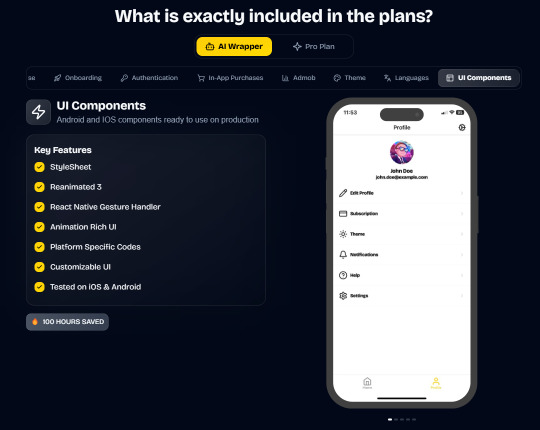
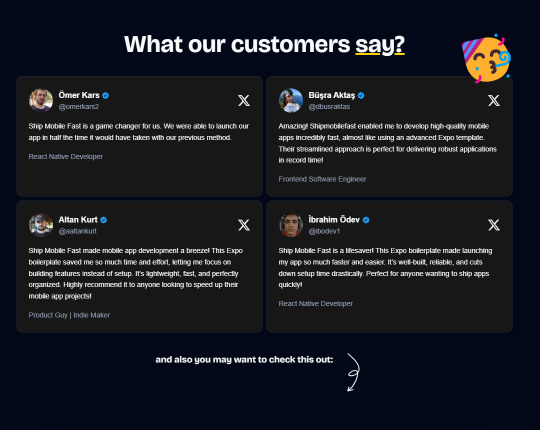
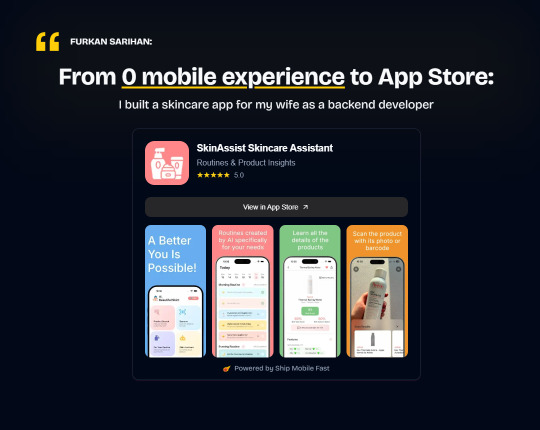
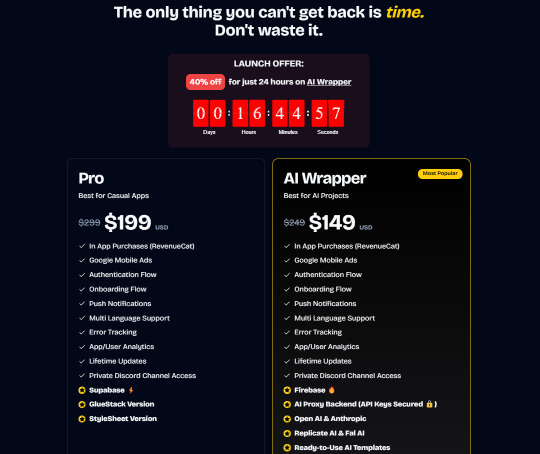
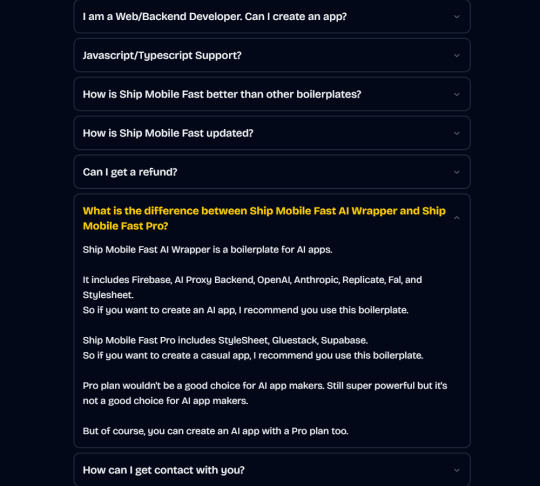
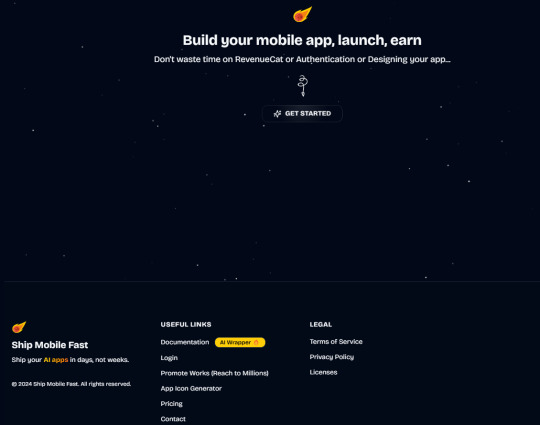
#ai#app#ship#mobile#fast#openai#claude#deepseek#proxy#api#admob#ads#firebase#supabase#falai#backend#ui#ux#replicate#revenuecat#google#expo#boilerplate#template#wrapper
2 notes
·
View notes
Text
Component Libraries: Should You Build Your Own or Use a Prebuilt One?

Component libraries are a vital tool in web application development in maintaining uniform design, shortening the time taken to develop web applications and improving reusability of the code. Some developers find this dilemma; should they create a component library or use an existing one? In addition, they help reduce the struggle while building well-designed and interactive websites because of the availability of animation-oriented UIs such as Accentricity UI among others. Now, let’s get more to the point in order to help you find the right way.
What is a Component Library?
Component libraries are collections of reusable UI elements such as buttons, forms, modals, and more— and are intended to reuse the components across several projects. Such libraries not only guarantee a consistent look of an application but also save time and costs during its implementation because the elements have been already coded. So, there's no need to build components from scratch.
Prebuilt Component Libraries

Prebuilt Component Libraries
Prebuilt component libraries are the ready-made collections of different UI components that are specifically designed and optimized for common use cases that developers can face during development. Some well-known examples include:
Material-UI (MUI):
A library based on React and it follows Google's Material-UI design, MUI allows a comprehensive set of components customization.
Ant Design:
It's an UI design system framework for enterprise-level products, ant design offers built-in themes and a rich set of UI components.
Bootstrap:
It's an widely-used CSS framework that provides basic components and a responsive grid system.
Pros of Prebuilt Libraries :
Rapid Development: Prebuilt libraries save a lot of time of the developers by providing pre-designed reusable components that you can quickly integrate into your project.
Standardized Design: They help ensure a consistent user experience across different screens and features.
Community Support: Many prebuilt libraries come with robust community support, providing a wealth of tutorials, plugins, and enhancements.
Cons of Prebuilt Libraries
Limited Customization: Customizing components to fit your unique design can sometimes be difficult, leading to constraints on flexibility.
Performance Overhead: Many prebuilt libraries come with extra features you may not need, which can bloat your codebase.

Pros And Cons of Prebuilt Libraries
Animation-Centric Libraries: Bringing UIs to Life
In recent years, a new category of libraries has emerged, specifically focused on providing built-in animations and smooth UI transitions. These libraries not only offer pre-designed components but also emphasize adding dynamic, interactive features to web applications.
Here are some popular examples of animation-focused libraries:
Lottie
Category: Animation Integration Library

Lottie:The industry standard for motion design
What it Offers: Lottie allows you to render animations created in Figma or Adobe After Effects as JSON files using the built-in plugins. These animations are then rendered natively on the web, offering high-quality motion without a heavy performance impact.
Why It’s Useful: Lottie is perfect for apps or websites requiring rich, scalable animations that are lightweight. It’s commonly used for logos, loading animations, and subtle UI effects. Unlike other component libraries, it focuses purely on bringing visual design elements from tools like Figma & After Effects into the web environment.
Accentricity UI
Category: Hybrid Component and Animation Library
What it Offers:
Accentricity UI combines traditional UI components with built-in support for smooth animations and transitions. It offers a wide range of components like buttons, forms, modals, and navigation menus, but with an added layer of predefined animations, making it easier to create interactive, dynamic interfaces.
In addition to these standard components, Accentricity UI provides responsive behaviors and subtle animation effects like hover states, fade-ins, and sliding transitions that enhance user engagement. The library's components are fully customizable, allowing developers to easily adjust animation timings, easing functions, and durations to match the look and feel of their brand, ensuring both visual appeal and performance across devices.
Why It’s Useful:
Think about it, what would be easy for a dev? Making a custom component with tons of animation which the dev has to write from scratch and polish it before the deadline or use a library, where the dev can make use of the library with the built-in support to combine the custom designed elements with smooth animations and transitions offered by the library.
It’s particularly helpful for developers who want the convenience of a prebuilt library but need polished, built-in animations to enhance user experience without writing complex animation code from scratch.
Framer Motion
Category: Animation-focused Component Library (React)

Framer Motion
What it Offers:
Framer Motion is a powerful library for React that allows you to create fluid animations and micro interactions with minimal effort. It supports interactive features like drag, scroll, and spring-based animations, which makes it ideal for interactive & highly animated UIs. It also provides easy-to-use APIs for gesture-based animations and layout transitions, offering developers extensive control over complex animations while maintaining simplicity in implementation.
Why It’s Useful:
Framer Motion combines the simplicity of component libraries with the flexibility of advanced animation frameworks, making it easy to enhance user interfaces with dynamic visual effects. It’s a great choice for React developers who want to integrate animation without compromising performance or adding significant overhead. With its built-in optimizations for smooth rendering, Framer Motion ensures high-quality animations that enhance both usability and visual appeal.
Should You Use Prebuilt Animation Libraries?
The role of animations is really important in web applications to enhance the UX(user experience), by making interfaces feel more fluid and interactive makes user's remember the website due to its great experience. Since users are constantly getting used to smooth effects, micro-interaction and dynamic feedback, animations are no longer viewed as a good to have feature but are rather considered as a must have feature. Prebuilt animation libraries like Framer Motion and GSAP (GreenSock Animation Platform) simplify this process by providing powerful, flexible tools that allow developers to integrate complex animations without having to manually manage every aspect of motion or dive deep into animation theory.
Advantages of Animation-Centric Libraries

Advantages of Animation-Centric Libraries
Ease of Use
Prebuilt animation libraries abstract away the complexities of coding animations from scratch. Without manually writing keyframes, easing functions, or browser-optimized transitions, developers can simply use predefined APIs to implement fluid animations. This drastically reduces development time, as many animation details are handled by the library, letting developers focus on building features and interactions rather than tweaking animations for performance or cross-browser compatibility. For example, with a few lines of code, animations can be applied to any UI element, making the development process much more efficient.
Advanced Features
Many animation libraries offer advanced features that go far beyond basic transitions like fade-ins and slide animations. These include timeline control, scroll-triggered animations, physics-based interactions, and even 3D transformations. For instance, timeline control allows developers to create synchronized sequences of animations, which can be used to create smooth, coordinated interactions across multiple elements. Scroll-based animations enhance user engagement by triggering effects as the user scrolls, perfect for parallax websites or content reveal effects. Physics-based animations, such as spring-based drag-and-drop or object bouncing, add natural, realistic movement to interactive elements, elevating the overall experience. Additionally, 3D transformations provide extensive control over how objects rotate, scale, or move in three-dimensional space, something that is cumbersome to achieve with native CSS alone.
See What Happens Next
#webdevelopement#werbooz#own website#build vs prebuilt component library#custom UI components#prebuilt UI libraries#web development#Material-UI#Ant Design#Bootstrap#Framer Motion#Accentricity UI#animation libraries#best UI libraries 2024#component library pros and cons#web app development#UI design optimization#web performance#web development trends
2 notes
·
View notes
Text
Best Bitcoin Alternatives: Exploring Top Cryptocurrencies for 2024 by Simplyfy
Bitcoin, the pioneering cryptocurrency, has long been the standard-bearer in the world of digital currencies.
However, the crypto market has grown exponentially, and several preferences to Bitcoin now provide special points and benefits. This article, promoted via Simplyfy, targets to information you via the fantastic Bitcoin choices for 2024, supporting you make knowledgeable choices in the evolving panorama of digital assets.
Introduction to Bitcoin and Its Alternatives
Bitcoin, introduced in 2009 by the pseudonymous Satoshi Nakamoto, revolutionized the financial world by introducing a decentralized form of currency.
Its meteoric upward shove in fees and massive adoption have paved the way for lots of different cryptocurrencies. These alternatives, frequently referred to as altcoins, serve a number of purposes, from improving privateness and enhancing transaction speeds to imparting revolutionary structures for decentralized purposes (DApps).
Why Look Beyond Bitcoin?
While Bitcoin remains a cornerstone of the crypto market, there are several reasons why investors and enthusiasts might seek alternatives:
1. Scalability: Bitcoin's transaction speed and scalability have been points of contention.
Some selections provide quicker and extra scalable solutions.
2. Transaction Fees: As Bitcoin's network becomes busier, transaction fees can rise.
Some altcoins supply less expensive transaction costs.
3. Utility: Many altcoins are designed with specific use cases in mind, from smart contracts to privacy features.
4. Investment Diversification: Diversifying one's portfolio with multiple cryptocurrencies can mitigate risk and potentially increase returns.
Top Bitcoin Alternatives in 2024
1. Ethereum (ETH)
Overview: Launched in 2015 by Vitalik Buterin, Ethereum is more than just a cryptocurrency.
It’s a decentralized platform that allows builders to construct and set up clever contracts and decentralized purposes (DApps).
Key Features:
Smart Contracts: Self-executing contracts with the terms of the agreement directly written into code.
Decentralized Applications (DApps): Applications that run on a decentralized network.
Ethereum 2.0: The ongoing improvement to Ethereum goals to enhance scalability, security, and sustainability via a shift from Proof of Work (PoW) to Proof of Stake (PoS).
Pros:
- Highly versatile platform with numerous use cases.
- Strong developer community.
- Continuous improvement and scalability through Ethereum 2.0.
Cons:
- High transaction fees (gas fees) during network congestion.
- Complex for new users compared to simpler cryptocurrencies.
2. Binance Coin (BNB)
Overview: Binance Coin is the native cryptocurrency of the Binance Exchange, one of the largest cryptocurrency exchanges in the world. Initially launched as an ERC-20 token on the Ethereum blockchain, BNB has since transitioned to the Binance Chain.
Key Features:
Exchange Utility: Primarily used to pay for trading fees on Binance, offering discounts to users.
Binance Smart Chain (BSC): Supports smart contracts and is known for its low transaction fees and high throughput.
Pros:
- Strong backing and integration with the Binance Exchange.
- Low transaction fees on BSC.
- Continuous development and use cases expanding beyond the Binance platform.
Cons:
The centralized nature of Binance raises concerns among decentralization purists.
- Regulatory scrutiny due to its association with Binance.
3. Cardano (ADA)
Overview: Cardano is a third-generation blockchain platform founded by Charles Hoskinson, a co-founder of Ethereum. It aims to provide a more balanced and sustainable ecosystem for cryptocurrencies.
Key Features:
Proof of Stake (PoS): Uses the Ouroboros PoS protocol, which is energy efficient.
Research-Driven: Development is backed by peer-reviewed academic research.
Scalability and Interoperability: Designed to improve scalability and interoperability compared to previous generations of blockchain.
Pros:
- Strong focus on security and sustainability.
- Continuous updates and improvements.
- Active community and developer involvement.
Cons:
- Slow development process due to its research-driven approach.
- Still in the early stages compared to some competitors.
4. Solana (SOL)
Overview: Solana is a high-performance blockchain supporting builders around the world creating crypto apps that scale today. It aims to provide decentralized finance solutions on a scalable and user-friendly blockchain.
Key Features:
Proof of History (PoH): A unique consensus algorithm that provides high throughput.
Low Transaction Fees: Designed to offer low-cost transactions.
Scalability: Capable of handling thousands of transactions per second.
Pros:
- Extremely fast and scalable.
- Low transaction costs.
- A growing ecosystem of DApps and DeFi projects.
Cons:
- Relatively new and still proving its stability.
- Centralization concerns due to the small number of validators.
5. Polkadot (DOT)
Overview: Founded by Dr. Gavin Wood, another co-founder of Ethereum, Polkadot is a heterogeneous multi-chain framework.
It approves a number of blockchains to switch messages and fees in a trust-free fashion.
Key Features:
Interoperability: Connects multiple blockchains into a single network.
Scalability: Enables parallel processing of transactions across different chains.
Governance: Decentralized governance model allowing stakeholders to have a say in the protocol's future.
Pros:
- Focus on interoperability and connecting different blockchains.
- High scalability potential.
- Strong developer and community support.
Cons:
The complexity of the technology might pose a barrier to new users.
- Competition with other interoperability-focused projects.
6. Chainlink (LINK)
Overview: Chainlink is a decentralized oracle network providing reliable, tamper-proof data for complex smart contracts on any blockchain.
Key Features:
Oracles: Bridges the gap between blockchain and real-world data.
Cross-Chain Compatibility: Works with multiple blockchain platforms.
Decentralized Data Sources: Ensures data reliability and security.
Pros:
- Unique and crucial role in enabling smart contracts to interact with external data.
- Strong partnerships with major companies and blockchains.
- Growing use cases and applications.
Cons:
- Highly specialized use cases might limit broader adoption.
- Dependence on the success of the smart contract ecosystem.
7. Ripple (XRP)
Overview: Ripple aims to enable instant, secure, and low-cost international payments.
Unlike many different cryptocurrencies, Ripple focuses on serving the desires of the monetary offerings sector.
Key Features:
RippleNet: A global network for cross-border payments.
XRP Ledger: A decentralized open-source product.
Speed and Cost: Provides fast transactions with minimal fees.
Pros:
- Strong focus on financial institutions and cross-border payments.
- Low transaction fees and fast settlement times.
- Significant partnerships with banks and financial institutions.
Cons:
- Centralization concerns due to Ripple Labs’ control.
- Ongoing legal issues with regulatory authorities.
8. Litecoin (LTC)
Overview: Created by Charlie Lee in 2011, Litecoin is often considered the silver to Bitcoin’s gold.
It targets to supply fast, low-cost repayments by way of the usage of a one-of-a-kind hashing algorithm.
Key Features:
Scrypt Algorithm: Allows for faster transaction confirmation.
SegWit and Lightning Network: Implements advanced technologies for scalability.
Litecoin Foundation: Active development and community support.
Pros:
- Faster transaction times compared to Bitcoin.
- Lower transaction fees.
- Active development and widespread adoption.
Cons:
- Limited additional functionality beyond being a currency.
- Competition from newer and more versatile cryptocurrencies.
9. Stellar (XLM)
Overview: Stellar is an open network for storing and moving money.
Its aim is to allow monetary structures to work collectively on a single platform.
Key Features:
Stellar Consensus Protocol (SCP): Allows for faster and cheaper transactions.
Anchor Network: Connects various financial institutions to the Stellar network.
Focus on Remittances: Facilitates cross-border payments and remittances.
Pros:
- Low transaction fees and high speed.
- Focus on financial inclusion and connecting global financial systems.
- Strong partnerships and adoption in the financial sector.
Cons:
- Competition from other payment-focused cryptocurrencies.
- Centralization concerns regarding development control.
10. Monero (XMR)
Overview: Monero is a privacy-focused cryptocurrency that aims to provide secure, private, and untraceable transactions.
Key Features:
Privacy: Uses advanced cryptographic techniques to ensure transaction privacy.
Decentralization: Emphasizes decentralization and security.
Fungibility: Every unit of Monero is indistinguishable from another.
Pros:
- Strong privacy and security features.
- Active community focused on maintaining privacy.
- Continuous development and improvements.
Cons:
- Privacy focus attracts regulatory scrutiny.
- Not as widely accepted as other cryptocurrencies.
Conclusion
The cryptocurrency market affords a plethora of options to Bitcoin, every with its special features, advantages, and viable downsides.
Whether you're looking for faster transaction speeds, lower fees, advanced functionalities like smart contracts, or enhanced privacy, there is likely a cryptocurrency that meets your needs. Ethereum, Binance Coin, Cardano, Solana, Polkadot, Chainlink, Ripple, Litecoin, Stellar, and Monero are among the top contenders worth considering in 2024.
As with any investment, it is quintessential to behavior thoroughly lookup and reflect on consideration on your monetary dreams and hazard tolerance. The crypto market is quite risky and can be unpredictable. Diversifying your investments and staying knowledgeable about market tendencies and technological developments can assist you navigate this.
#simplyfy#news#bitcoin#cryptocurrency#crypto#blockchain#digitalcurrency#cryptonews#cryptotrading#simplyfycrypto#simplyfynews
3 notes
·
View notes
Text
From Novice to Pro: Unleash Your DevOps Wizardry with Our Game-Changing Course
Are you eager to unlock your full potential as a DevOps expert? Look no further! Our comprehensive and ground breaking course is designed to empower individuals like you to transform from a novice into a pro in the realm of DevOps. In this article, we will delve into the various facets of this course, providing you with the essential education and vital information needed to embark on this thrilling journey. Brace yourself for an enlightening experience that will take your IT skills to unparalleled heights.

Education: The Key to Success
Embrace the Fundamentals
Before diving headfirst into the vast world of DevOps, it is imperative to establish a solid foundation. Our course begins by acquainting you with the fundamental concepts and principles that underpin DevOps. Through a meticulous blend of theory and practical application, you will grasp essential concepts such as continuous integration, continuous delivery, and automation. Embracing these fundamentals will enable you to comprehend the underlying philosophy of DevOps, enabling you to tackle complex challenges with confidence and finesse.
Master the Tools of the Trade
In the ever-evolving landscape of IT, proficiency in the right tools can make all the difference. Our course ensures that you become well-versed in the latest and most powerful DevOps tools available today. From configuration management platforms like Chef and Puppet to container orchestration systems such as Kubernetes, our curriculum covers a wide array of technologies that are essential for any aspiring DevOps wizard. Guided by experienced instructors, you will gain hands-on experience and develop a keen understanding of how these tools can streamline processes and enhance efficiency.
Collaboration and Communication
DevOps is not merely about technology; it is a cultural shift that emphasizes collaboration and communication within teams. Understanding how to foster effective teamwork and seamless interaction is pivotal in becoming a DevOps maestro. Our course places a strong emphasis on cultivating these essential soft skills. By exploring methodologies like Agile and Lean, you will discover how to break down silos, foster cross-functional collaboration, and promote a culture of shared responsibility. Unleashing your potential in this domain will enable you to bridge gaps between departments, leading to empowered teams and accelerated project delivery.
Information: Knowledge is Power
Stay Ahead of the Curve
In the dynamically evolving IT landscape, staying abreast of the latest trends and emerging practices is paramount. Our course goes beyond the basics, equipping you with up-to-date information on cutting-edge technologies and industry best practices. With a finger on the pulse of the DevOps community, our instructors ensure that you receive timely insights into the latest advancements and trends. From cloud-native architectures to infrastructure as code, you will gain a thorough understanding of the innovations shaping the future of DevOps.
Real-World Case Studies
Theoretical knowledge alone is often insufficient in preparing for real-world scenarios. That's why our course incorporates a range of real-world case studies that offer valuable insights and practical applications. By examining success stories and lessons learned from industry leaders, you will gain invaluable wisdom about overcoming hurdles and delivering exceptional results. These case studies provide a glimpse into the challenges faced by seasoned DevOps professionals and present you with the opportunity to hone your problem-solving skills in a safe and supportive environment.
Continuous Learning and Community Engagement
DevOps is a vibrant and dynamic community that thrives on collaboration and continuous learning. Our course not only equips you with the tools and knowledge you need, but it also encourages you to actively engage with the DevOps community. Through forums, discussion boards, and networking opportunities, you will join a network of like-minded individuals, fostering connections with experienced practitioners and expanding your professional horizons. This engagement will enable you to stay informed, exchange ideas, and grow alongside the ever-evolving DevOps ecosystem.
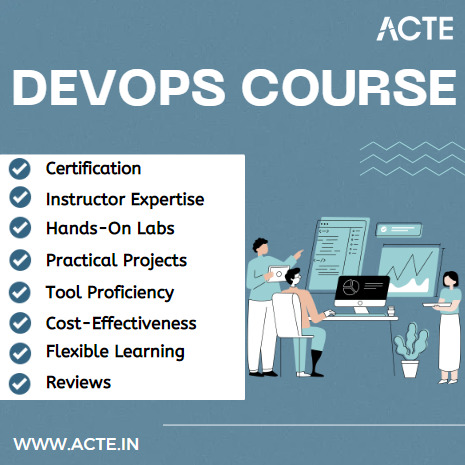
IT: The Pathway to Success
Career Advancement Opportunities
With the rapid adoption of DevOps practices, the demand for skilled professionals has skyrocketed. Our course is designed to propel your career to new heights by equipping you with the skills and knowledge sought after by top organizations worldwide. Whether you aspire to become a DevOps engineer, a systems architect, or a team leader, our course equips you with the tools needed to unlock doors to exciting career opportunities in the IT industry. Embrace this transformative experience and set yourself on a trajectory towards professional growth and success.
Enhanced Efficiency and Productivity
DevOps is synonymous with enhanced efficiency, improved collaboration, and increased productivity. By completing our course, you will possess the ability to streamline workflows, automate repetitive tasks, and foster a culture of continuous improvement. Armed with these skills, you will be able to eliminate bottlenecks, reduce time to market, and ensure seamless integration and delivery of software solutions. By unlocking the power of DevOps, you will become a catalyst for organizational success and drive tangible value for your team and stakeholders.
Embarking on the journey from novice to pro in the realm of DevOps is filled with challenges and opportunities. Our game-changing course provides the education, information, and IT skills needed to navigate this exciting landscape. By mastering the fundamentals, embracing the latest tools, and nurturing essential soft skills, you will transcend the boundaries and unleash your DevOps wizardry. Seize the opportunity to become a catalyst for organizational success and embark on a transformative journey that will set you apart as a DevOps expert. Enroll in our course today at ACTE institute and let your DevOps journey begin!
11 notes
·
View notes
Text
5 Common Mobile App Development Myths You Need to Stop Believing | Techgropse
In today's fast-paced digital landscape, mobile applications have become an integral part of our daily lives. Whether it's for social networking, productivity, or entertainment, mobile apps are ubiquitous. However, despite their prevalence, there are still many misconceptions surrounding mobile app development that can hinder the success of a project.
Developing A Mobile App Is Expensive And Time Consuming
One of the most widespread myths about mobile app development is that it's prohibitively expensive and time-consuming. While it's true that building a high-quality app requires investment, it doesn't have to break the bank. With advancements in technology and the availability of various development tools and platforms, the cost of app development has significantly decreased in recent years.
Additionally, there are several approaches to mobile app development Singapore, such as native, hybrid, and cross-platform development, each with its own set of pros and cons. By carefully considering your project requirements and budget constraints, you can choose the most cost-effective approach that meets your needs.
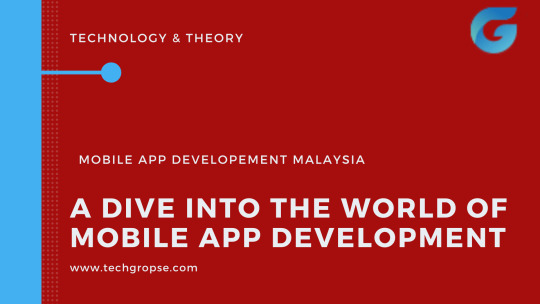
Building A Mobile App Guarantees Success
Another common misconception is that simply having a mobile app will guarantee success. While a well-designed and functional app is undoubtedly essential, it's just one piece of the puzzle. Success in the crowded app market requires more than just launching an app; it requires a comprehensive strategy encompassing marketing, user acquisition, retention, and monetization.
Furthermore, effective marketing and promotion are crucial for app success. Leveraging various channels such as app store optimization (ASO), social media, influencer marketing, and paid advertising can help increase app visibility and attract users.
Mobile App Development Is A One Time Effort
Some people mistakenly believe that a mobile app development company in Malaysia is a one-time effort—that once the app is launched, the work is done. However, the reality is that successful app development is an ongoing process that requires continuous updates, maintenance, and optimization.
Final Words :
Debunking these common myths about mobile app development is essential for ensuring the success of your app project. By understanding the realities of app development, leveraging the right tools and resources, and adopting a strategic approach, you can maximize your chances of creating a successful and impactful mobile app.
#app development#web application development#app developers#web app development#custom software development
2 notes
·
View notes
Text
Exploring the Pros and Cons of Selenium IDE for Test Automation
Introduction: Selenium IDE, a widely-used integrated development environment for Selenium, has garnered attention among testers for its ability to streamline automated test script creation. While it offers numerous advantages, it also presents certain limitations. In this comprehensive examination, we delve into the strengths and weaknesses of Selenium IDE, providing valuable insights to guide testers in their test automation endeavors.

Advantages of Selenium IDE:
1. User-Friendly Interface: Selenium IDE boasts an intuitive interface that simplifies the process of creating test scripts. Its user-friendly tools for recording and playback make it accessible to testers of all levels, including those with minimal programming experience.
2. Swift Test Development: A notable feature of Selenium IDE is its capacity for rapid test development. Testers can swiftly create automated test cases by recording user interactions with web applications, reducing the need for manual scripting and accelerating the development cycle.
3. No Programming Expertise Required: Unlike some other Selenium tools, Selenium IDE does not demand proficiency in programming languages. Testers can create automated tests without writing code, making it an attractive option for those new to automation or seeking a simplified approach.
4. Cross-Browser Testing Support: Selenium IDE facilitates cross-browser testing, enabling testers to execute test scripts across various web browsers such as Chrome, Firefox, and Safari. This ensures consistent application functionality across different browser environments.
5. Seamless Integration with Selenium WebDriver: Selenium IDE seamlessly integrates with Selenium WebDriver, allowing testers to export recorded test scripts to WebDriver-compatible programming languages like Java, Python, and C#. This interoperability enhances script flexibility and scalability for more complex testing scenarios.
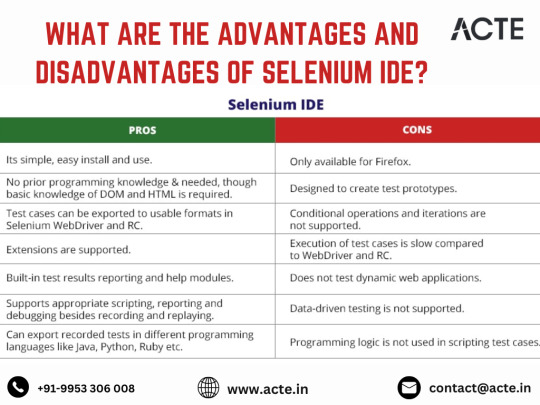
Disadvantages of Selenium IDE:
1. Limited Functionality: While Selenium IDE offers ease of use, its functionality is relatively limited compared to other Selenium tools such as WebDriver and Grid. It primarily focuses on basic test recording and editing, which may not suffice for complex testing requirements.
2. Browser Dependency: Selenium IDE's functionality is dependent on the browser, which can lead to compatibility issues and constraints. Changes in browser versions or updates may impact the reliability and performance of Selenium IDE, necessitating ongoing maintenance and updates.
3. Challenges with Dynamic Element Handling: Selenium IDE may encounter challenges when handling dynamic web elements and complex interactions. Its inability to effectively manage dynamic elements can restrict its usability in certain testing scenarios, requiring alternative approaches or additional tools.
4. Limited Script Reusability: Test scripts created in Selenium IDE may lack modularity and reusability, particularly for large test suites. Managing and organizing test scripts can be challenging, leading to increased maintenance overhead and reduced efficiency.
5. Absence of Native Parallel Testing Support: Selenium IDE does not natively support parallel testing, which may impact test execution speed and efficiency, particularly in large-scale automation projects. Testers may need to explore alternative solutions or utilize other Selenium tools for parallel execution.
Conclusion: In summary, Selenium IDE offers a user-friendly platform for automated test script creation, making it a valuable tool for testers across various skill levels. However, its limitations in terms of functionality, browser dependency, and lack of advanced features may pose challenges for complex testing scenarios. Testers should carefully evaluate the strengths and weaknesses of Selenium IDE to determine its suitability for their specific testing needs and project requirements.
2 notes
·
View notes
Text
Discover What A Pro Has To Say On The Learning Spanish For English Speakers
In today's global landscape, being fluent in multiple languages is obviously beneficial, giving individuals a significant advantage in the competitive professional field. Spanish, in particular, emerges as a language of considerable relevance, providing learners with several chances for personal and professional development. This essay looks in to the complexities of online Spanish language learning, with a particular focus on obtaining conversational fluency and the invaluable experiences gained through such endeavours. Without question, one of the major advantages of learning Spanish is the ability to reach the enormous Spanish-speaking globe. This linguistic proficiency allows use of a vast tapestry of cultures, various communities, and distinct perspectives. By participating in online Spanish sessions designed designed for English speakers, students position themselves to fluidly navigate this language terrain, forging relationships and understanding within an increasingly interconnected world. Conversational Spanish needs a solid command of the language's fundamentals. Are you hunting for learning spanish for english speakers? Visit the previously mentioned website.

Learners can benefit greatly from free online Spanish classes, including pre-recorded videos, presentations, and audio files. These courses promote flexible learning, letting students to delve into essential topics like vocabulary, phrases, and sentence formation. Furthermore, engaging with native Spanish speakers via forums and blogs adds a vibrant element to the learning experience, enabling practical application and interactive engagement. Active engagement in Spanish chat rooms, groups, and online discussion forums enhances the language learning experience. The capacity to communicate with native speakers not merely improves accents and tones but in addition provides an even more sophisticated grasp of the cultural nuances buried in the language. For individuals who prefer an even more structured approach, respected online universities provide affordable tutoring programmes. These programmes use many different platforms, including online chat rooms, Skype sessions, video conferencing, and interactive whiteboards, to provide a comprehensive and immersive learning environment. Before enrolling in an on the web Spanish tuition programme, a comprehensive evaluation of its effectiveness is required. Trial classes, curriculum examination, evaluation of teaching aids and technological integration, and feedback from previous students all help to see decision-making processes.
Choosing an arduous programme that emphasises constant progress monitoring via evaluations and practical examinations guarantees an energetic and effective learning experience. Engaging a native Spanish tutor online offers an enriching and personalised learning experience. Learners have 24/7 use of guidance, feedback, and timely ideas for development. The capability to plan sessions at convenient times and continue at your speed adds an active and operational dimension to the learning process. Mastering conversational Spanish through online study not only improves language skills but also provides access to a larger, more interconnected world. By concentrating on the very best online Spanish lessons for English speakers, incorporating practical experiences, and interacting with native speakers, students embark on a trip that crosses linguistic boundaries, revealing a further knowledge of diverse cultures and fostering meaningful connections in a rapidly changing global landscape.
3 notes
·
View notes
Text
PWA vs Native, Hybrid, SPA, MP: A Complete App Development Guide
In today's digital age, having a mobile app for your business is essential to stay ahead of the competition and cater to the growing needs of mobile users. However, when it comes to an app development company, there are several options to consider; one of them is Nivida Web Solutions Private Limited. Among the various approaches available, Progressive Web Apps (PWAs), Native apps, Hybrid apps, Single-Page Applications (SPAs), and Multi-Platform apps (MP) are the most popular choices. Each of these options has its own strengths and weaknesses. In this comprehensive app development guide, we will compare and contrast these different approaches to help you make an informed decision.
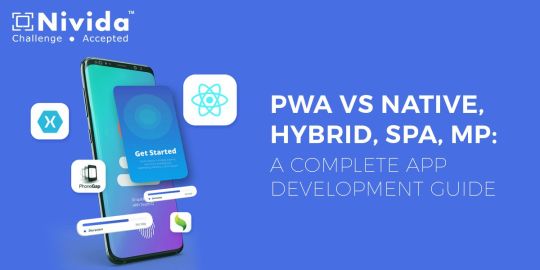
Progressive Web Apps (PWAs):
PWAs are web applications that are designed to look and function like native mobile apps. They are built using web technologies such as HTML, CSS, and JavaScript and are accessible through a web browser. PWAs are highly responsive, installable, and can work offline, making them an excellent choice for businesses looking to reach a wider audience across multiple platforms. Additionally, PWAs can be easily updated without requiring users to download new versions.
Native Apps:
Native apps are developed for specific platforms like iOS or Android using platform-specific languages (Swift or Objective-C for iOS, Java or Kotlin for Android). They offer the best performance, user experience, and access to device-specific features like camera, GPS, and push notifications. However, developing native apps requires separate codebases for different platforms, resulting in higher development costs and longer development cycles.
Hybrid Apps:
Hybrid apps are a combination of web and native apps. They are built using web technologies like HTML, CSS, and JavaScript and are wrapped in a native shell that enables them to be distributed through app stores. Hybrid apps provide a balance between cost-effectiveness and access to native features. However, they may not deliver the same performance as native apps, and certain device-specific functionalities might be limited.
Single-Page Applications (SPAs):
SPAs are web applications that load a single HTML page and dynamically update the content as users interact with the app. They offer a seamless user experience similar to native apps and can be accessed through web browsers. SPAs are easier to develop and maintain compared to native apps, but they may not provide the same level of performance and access to device features.
Multi-Platform Apps (MP):
Multi-platform apps are developed using cross-platform frameworks like React Native, Flutter, or Xamarin. These frameworks allow developers to write code once and deploy it across multiple platforms, saving time and effort. Multi-platform apps can achieve near-native performance and provide access to device features, making them a popular choice for businesses targeting multiple platforms.
When considering app development companies in India or Gujarat, it's essential to find a partner that understands your specific requirements and has expertise in the chosen development approach. Android App development companies in India and Gujarat offer a wide range of services, including native app development, hybrid app development, and PWA development. Similarly, Mobile App development companies in India and Gujarat can provide expertise in developing SPAs and MP apps.
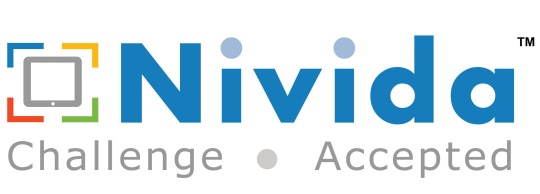
Before choosing an app development approach, consider factors such as budget, target audience, performance requirements, and time-to-market. Each approach has its own pros and cons, and the decision should align with your business goals and objectives. Consulting with a reputable app development company, Nivida Web Solutions Private Limited can help you navigate through these choices and make the right decision for your business.
In conclusion, the choice between PWAs, Native apps, Hybrid apps, SPAs, and MP apps depends on various factors such as performance, cost, development time, and target audience. Each approach has its own merits, and it's important to evaluate them based on your specific needs when selecting an app development company in India.
#eCommerce development company in India#eCommerce development Companies in Gujarat#Mobile App development Companies in India#Mobile App development company in Gujarat#Android App development Companies in India#Android App development company in Gujarat#Digital Marketing company in India
6 notes
·
View notes
Text
Service Mesh with Istio and Linkerd: A Practical Overview
As microservices architectures continue to dominate modern application development, managing service-to-service communication has become increasingly complex. Service meshes have emerged as a solution to address these complexities — offering enhanced security, observability, and traffic management between services.
Two of the most popular service mesh solutions today are Istio and Linkerd. In this blog post, we'll explore what a service mesh is, why it's important, and how Istio and Linkerd compare in real-world use cases.
What is a Service Mesh?
A service mesh is a dedicated infrastructure layer that controls communication between services in a distributed application. Instead of hardcoding service-to-service communication logic (like retries, failovers, and security policies) into your application code, a service mesh handles these concerns externally.
Key features typically provided by a service mesh include:
Traffic management: Fine-grained control over service traffic (routing, load balancing, fault injection)
Observability: Metrics, logs, and traces that give insights into service behavior
Security: Encryption, authentication, and authorization between services (often using mutual TLS)
Reliability: Retries, timeouts, and circuit breaking to improve service resilience
Why Do You Need a Service Mesh?
As applications grow more complex, maintaining reliable and secure communication between services becomes critical. A service mesh abstracts this complexity, allowing teams to:
Deploy features faster without worrying about cross-service communication challenges
Increase application reliability and uptime
Gain full visibility into service behavior without modifying application code
Enforce security policies consistently across the environment
Introducing Istio
Istio is one of the most feature-rich service meshes available today. Originally developed by Google, IBM, and Lyft, Istio offers deep integration with Kubernetes but can also support hybrid cloud environments.
Key Features of Istio:
Advanced traffic management: Canary deployments, A/B testing, traffic shifting
Comprehensive security: Mutual TLS, policy enforcement, and RBAC (Role-Based Access Control)
Extensive observability: Integrates with Prometheus, Grafana, Jaeger, and Kiali for metrics and tracing
Extensibility: Supports custom plugins through WebAssembly (Wasm)
Ingress/Egress gateways: Manage inbound and outbound traffic effectively
Pros of Istio:
Rich feature set suitable for complex enterprise use cases
Strong integration with Kubernetes and cloud-native ecosystems
Active community and broad industry adoption
Cons of Istio:
Can be resource-heavy and complex to set up and manage
Steeper learning curve compared to lighter service meshes
Introducing Linkerd
Linkerd is often considered the original service mesh and is known for its simplicity, performance, and focus on the core essentials.
Key Features of Linkerd:
Lightweight and fast: Designed to be resource-efficient
Simple setup: Easy to install, configure, and operate
Security-first: Automatic mutual TLS between services
Observability out of the box: Includes metrics, tap (live traffic inspection), and dashboards
Kubernetes-native: Deeply integrated with Kubernetes
Pros of Linkerd:
Minimal operational complexity
Lower resource usage
Easier learning curve for teams starting with service mesh
High performance and low latency
Cons of Linkerd:
Fewer advanced traffic management features compared to Istio
Less customizable for complex use cases
Choosing the Right Service Mesh
Choosing between Istio and Linkerd largely depends on your needs:
Choose Istio if you require advanced traffic management, complex security policies, and extensive customization — typically in larger, enterprise-grade environments.
Choose Linkerd if you value simplicity, low overhead, and rapid deployment — especially in smaller teams or organizations where ease of use is critical.
Ultimately, both Istio and Linkerd are excellent choices — it’s about finding the best fit for your application landscape and operational capabilities.
Final Thoughts
Service meshes are no longer just "nice to have" for microservices — they are increasingly a necessity for ensuring resilience, security, and observability at scale. Whether you pick Istio for its powerful feature set or Linkerd for its lightweight design, implementing a service mesh can greatly enhance your service architecture.
Stay tuned — in upcoming posts, we'll dive deeper into setting up Istio and Linkerd with hands-on labs and real-world use cases!
Would you also like me to include a hands-on quickstart guide (like "how to install Istio and Linkerd on a local Kubernetes cluster")? 🚀
For more details www.hawkstack.com
0 notes
Text
Master the Art of Coding with a Full Stack Developer Certification.
The demand for qualified full-stack developers is soaring in today's tech-driven environment. A thorough full stack development certification can be your passport to success if you want to enter the field or advance in your current position. This article will discuss why this certification is revolutionary and how it may help you become an expert coder.
The Full Stack Frenzy
The tech landscape is in constant flux, and companies are seeking versatile developers who can handle both front-end and back-end development. A Full Stack Developer is the jack-of-all-trades of the coding world, capable of building complete web applications from start to finish.
High Demand, High Rewards:The demand for full-stack developers consistently outpaces supply.This translates to excellent job opportunities and competitive salaries.Companies value their ability to bridge the gap between front-end and back-end.This demand creates a stable and lucrative career path.
End-to-End Control:Full stack developers have a holistic understanding of web applications.They can troubleshoot issues across the entire stack.This control leads to better code quality and performance.They can contribute to the entire development lifecycle, from concept to deployment.
A Solid Full Stack Certification Covers
A robust Full Stack Developer certification program should equip you with the essential skills and knowledge required to succeed in the industry. It should cover a wide range of technologies,
Problem-Solving and Algorithmic Thinking:Developing strong problem-solving skills is essential for debugging and optimization.Understanding data structures and algorithms is crucial for efficient coding.The ability to think logically and creatively is vital for tackling complex problems.These skills are the bedrock of a successful coding career.
Trending Technologies to Focus On
The tech world is constantly evolving, so staying up-to-date with the latest trends is crucial. Here are some trending technologies that a modern Full Stack Developer certification should include:
Serverless Architecture:This allows developers to build and run applications without managing servers.Services like AWS Lambda and Azure Functions are gaining popularity.Serverless computing offers scalability and cost-efficiency.This approach is revolutionizing how applications are deployed and managed.
Progressive Web Apps (PWAs):PWAs offer a native app-like experience within a web browser.They are fast, reliable, and installable on mobile devices.PWAs are gaining traction due to their enhanced user experience.This technology is bridging the gap between web and mobile applications.
GraphQL:GraphQL is a query language for APIs that provides more flexibility than REST.It allows clients to request only the data they need.GraphQL is becoming increasingly popular for building efficient APIs.This technology improves API performance and simplifies data retrieval.
Your Journey to Coding Pro Starts Now
Earning a Full Stack Developer certification is an investment in your future. It can open doors to exciting career opportunities and empower you to build innovative web applications. By focusing on the right technologies and choosing a reputable certification program, you can transform yourself from a coding novice to a coding pro. Embrace the challenge, stay curious, and embark on your journey to becoming a sought-after full-stack developer.
For more information Visit our- https://www.gsdcouncil.org/certified-full-stack-developer
For more inquiries - +91 7796699663.
#full stack development certification#best full stack developer certification#certification for full stack developer#certified professional in full stack development#full stack certification exam#full stack developer certification exam#certified full stack developer#full stack developer exam#python full stack developer certification#full stack developer certification#full stack certification#best full stack certification.
0 notes
Text
Flutter vs. React Native: Best Choice for Food Delivery App Development
Hey there! So, you’re thinking about developing a food delivery app, and you’re trying to figure out whether Flutter or React Native is the right choice for your business. First off, you’re already on the right track by considering these two platforms—they’re the top contenders for building cross-platform apps, which means you’ll be able to launch your food delivery service on both iOS and Android with just one codebase. Pretty amazing, right?
As a Food Delivery App Development Company, I’ve worked with both of these frameworks, and today, I’m going to break down the pros and cons of each to help you make the best decision for your business. Whether you're running a small restaurant, a local business, or a larger enterprise, I want you to feel confident that you’re making the right choice for your food delivery app solution. So, let's dive in!
What Are Flutter and React Native?
Before we get into the comparison, let's quickly go over what each framework is all about.
Flutter is Google’s open-source UI toolkit for building natively compiled applications for mobile, web, and desktop from a single codebase. It uses the Dart programming language and is known for its rich set of pre-designed widgets and its focus on smooth, high-performance UI.
React Native, on the other hand, is a popular open-source framework developed by Facebook. It allows developers to use JavaScript (which is one of the most widely-used languages) to build mobile apps. React Native is known for being easy to integrate with existing apps and for its large, active community of developers.
So, Which One Should You Choose for Your Food Delivery App?
Now, let's break down how each of these frameworks stacks up for food delivery app development. There are a few key factors to consider here, and I’ll go through them one by one.
1. Development Speed and Ease of Use
As a restaurant owner or small business, speed is often of the essence. You want your food delivery app solution up and running quickly, without unnecessary delays.
Flutter: Flutter's "hot reload" feature is a major advantage. It allows you to see changes in real-time without restarting the app. This makes development faster and more efficient. It also has a rich set of pre-built widgets, which means you don’t need to build everything from scratch.
React Native: React Native also has "hot reload" functionality, so you're in good hands either way. However, React Native requires more reliance on third-party libraries for certain features, which can sometimes lead to bugs or compatibility issues. But, in general, it’s a little easier for developers who are already familiar with JavaScript.
Winner: Flutter takes the edge here, especially if you need a fast turnaround and have a team that can work efficiently with its UI toolkit.
2. Performance
Performance is a biggie when it comes to food delivery apps. Your customers expect fast, smooth interactions—whether they’re ordering food, tracking their delivery, or paying for their meal.
Flutter: Flutter is known for its high performance. Since it’s compiled to native code, it tends to run more smoothly, especially for graphic-intensive applications. If your food delivery app requires real-time tracking, geolocation features, or smooth animations, Flutter is a solid choice.
React Native: React Native uses a bridge to communicate with native modules, which means it’s not always as fast as Flutter, especially in complex applications. However, for most food delivery apps, it’s still pretty fast, and you can optimize performance with native code when necessary.
Winner: Flutter has a slight edge here, particularly if performance is a top priority for your app’s real-time features (think: live order tracking and navigation).
3. Customization and UI/UX
When you’re building a food delivery app, the user interface (UI) and user experience (UX) are crucial. You want your customers to enjoy using your app, and a smooth, intuitive interface goes a long way.
Flutter: Flutter is renowned for its beautiful UI capabilities. You get a lot of flexibility with its customizable widgets, which can help you create a visually rich and highly interactive experience. It’s perfect for food delivery apps that want to offer a sleek, modern design.
React Native: React Native offers a great user experience as well, but you might run into a few limitations when it comes to design customization. That said, there are plenty of third-party libraries and tools that can help, so it’s still a solid choice for most app designs.
Winner: Flutter takes the win here, especially if a stunning, custom UI is important to your brand and app.
4. Community Support and Ecosystem
If you're like most business owners, you’re probably thinking about long-term maintenance and how easy it will be to scale your app. The community support and available libraries are big factors in this decision.
Flutter: Flutter has grown rapidly, and while it doesn’t have quite as large a community as React Native, it’s catching up quickly. It’s also backed by Google, so you know it's here to stay. There’s a solid ecosystem of packages and plugins, and things are improving every day.
React Native: React Native has been around longer, which means it has a huge community and plenty of libraries and plugins available. You’ll likely find everything you need, and if something’s missing, it’s easy to find solutions or workarounds.
Winner: React Native wins this round for its bigger community and wider range of third-party libraries, but Flutter is definitely gaining ground fast.
5. Cost-Effectiveness
You’re probably also wondering which of these frameworks will give you the best bang for your buck. After all, building a food delivery app is a big investment!
Flutter: Even though Flutter might require more development time initially (due to the learning curve of Dart for some developers), it allows you to write once and deploy to both iOS and Android, which saves costs in the long run.
React Native: React Native is generally faster to develop with, especially if your development team is already familiar with JavaScript. It’s a cost-effective option, especially if you want to scale quickly or need to make a lot of iterative changes.
Winner: React Native is a bit more cost-effective upfront, especially for teams experienced with JavaScript.
Conclusion: Which Is Best for Your Food Delivery App?
At the end of the day, both Flutter and React Native are excellent choices for food delivery app development. It really comes down to your specific needs:
If you want blazing performance, a custom UI, and top-notch visuals, Flutter might be the better choice for your food delivery app.
If you’re looking for a cost-effective solution with a bigger community and faster development, React Native will get you up and running quicker.
As a Food Delivery App Development Company, I always recommend considering the long-term goals of your app, your budget, and the specific features you want to offer. Both of these frameworks are capable of bringing your food delivery app solution to life—you just need to choose the one that aligns best with your business goals.
Have you decided which framework is right for your food delivery app? If you need help or want to explore the possibilities further, feel free to reach out! I’m always here to chat about how you can build a successful app that delights your customers and helps your business grow.
Which framework are you leaning towards—Flutter or React Native? Drop me a comment below, and let’s continue the conversation!
0 notes
Text
Intel Quartus Prime Pro Edition 25.1 Optimized for Agilex 3

Altera Launches Quartus Prime Pro Edition 25.1 for Agilex 3 FPGAs
Now available is Quartus Prime Pro 25.1, which supports Agilex 3, the latest Agilex release. Developers may design high-performing, power-efficient edge and embedded programs with this update.
Comprehensive Agilex 3 FPGA support
Agilex 3 FPGA family offers cost optimisation, high performance, and power efficiency for edge and embedded applications. This version lets you develop, test, and implement solutions faster with Agilex 3 higher-speed transceivers, on-chip dual Cortex-A55 ARM CPUs, and increased memory support, including LPDDR4.
For small board space applications, Agilex 3 uses Intel's variable pitch BGA packaging to design more efficiently and compactly. With this technology, developers can maintain performance and power efficiency while adding functionality to smaller spaces.
Security is essential for FPGA applications to protect sensitive data and IP. Agilex 3's physical security, authentication, and encryption capabilities strengthen designs' manipulation and assault resistance.
Nios V Soft Processor Enhancements
Nios V is vital for embedded applications and improves efficiency and performance. These improvements allow developers to make smaller, more efficient embedded devices.
Improved Nios V/g Core Performance Improved work completion and overall performance.
Nios V/c Core Area reduction saves 8% space, leading in smaller designs.
The Ashling RISCFree IDE's Visual Studio Code plugin simplifies Nios V software development.
TinyML Example Design with Nios V Application Note lets developers add machine learning (ML) to FPGA designs utilising microcontrollers.
Features of Embed Software
FPGA-based embedded applications need strong OS and virtualisation support. By adding Linux, RTOS, and hypervisor support, Quartus Prime Pro 25.1 lets developers build scalable, real-time, and virtualised embedded systems.
Linux Hardware Reference Designs Regular and standard editions for Linux development.
To support Xen, developers can virtualise FPGA programs.
RTOS supports Zephyr and Bare Metal, and FreeRTOS will arrive in Q2 (May).
Installer Improvements: Faster, flexible configuration
FPGA software should install and adapt easily. Quartus Prime Pro 25.1 improves installation with parallel processing, configurable component selection, and file management.
Installation in Parallel speeds up setup by installing many components simultaneously.
By letting users choose just the bits they need, Dynamic Components decrease installation time and disc space.
Troubleshoot hardware quickly with streaming debugging
Effective debugging reduces development cycles. The Streaming Debug IP for Signal Tap helps engineers debug FPGA designs by capturing real-time, high-bandwidth data.
Hardware debugging streaming allows real-time data flow for analysis.
Configurable streaming via STP Signal Tap Logic Analyser configures streaming and selects a debug host.
Simulation Enhancements
Quartus Prime Pro 25.1 improves integration, long-term support, and simulation with new native Altera AXI4 Bus Functional Models (BFMs).
Optimised for Quartus simulation workflows, native Altera AXI4 BFMs increase performance and compatibility.
Smooth Change With better toolchain integration, customers may switch to Altera AXI4 BFMs without substantial modifications.
Quartus Prime Pro 25.1 improves simulation performance, notably for transceiver protocol IP, enabling faster debugging and verification.
Better Transceiver Protocol IP simulation enhances PCIe, Ethernet, Serial Lite, JESD, and other transceiver protocols.
25.1 Beta Models The new simulation models for this edition focus on Ethernet and PCIe and are under beta testing.
Improved Efficiency Usually, 50% or more improvements speed up verification and reduce simulation time.
These simulation additions improve Quartus Prime Pro 25.1's transceiver-based FPGA design capabilities by speeding up simulations and reducing verification time.
Extra Quartus Prime Pro 25.1 Updates
QPDS Standard & Pro Containerised Images Docker Hub offers Quartus Prime Standard and Pro Editions containerised, simplifying deployment and improving cloud and CI/CD compatibility.
Separating timed closure data from Design Assistant results simplifies failure classification in Summary of Design Closure.
SDC Relative File Paths improve portability and script management for Synopsys Design Constraints (SDC) reports.
MTBF improvements It lets users adjust instance toggling rates to improve MTBF when default toggle rates are not suitable.
Static timing analysis improvements in Quartus Prime Pro 25.1 speed up timing problem identification and resolution.
Synthesis supports basic Quad-Port RAM. Automatic quad-port RAM inference expands memory design flexibility.
Complete Support for Byte Enable Inference in Synthesis: This adds 8-bit byte enables and supports 5, 8, 9, and 10-bit combinations, matching hardware capabilities.
Correcter Management Users can now write individual bytes within a word using the byte enable control signal to increase memory access and performance.
Better RAM inference lets designers use FPGA memory more readily.
FPGA AI Suite: Improved Usability and AI
As AI advances, FPGA-based inference systems must be more flexible and effective. This release includes better performance estimation, model support, and Agilex FPGA integration.
Support Agilex 3 Beta FPGA AI Suite beta supports Agilex 3 FPGAs. Build in Quartus with Agilex 3 and generate Inference IP targeting Agilex 5 in the architectural configuration file.
The RPM and DEB packages are now called “altera-fpga-ai-suite-” and the AI Suite is installed in “/opt/altera” instead of “/opt/intel”.
YoloV7 Model Support enables high-accuracy object recognition in robotics, surveillance, and industrial quality control.
Agilex 5 FPGA E-Series Example Design Support New Agilex 5 FPGA E-Series 065B Modular Development Kit sample designs are available.
This SoC example uses an ARM host CPU for AI inference. AI Inference IP and a novel layout transform enable folding and run-time configurability to improve AI model performance and usability.
Example of Hostless JTAG-Attach Design A system console linked to the Inference IP via JTAG allows users to setup and control IP functionality step-by-step.
Performance Estimator Uses Memory Bandwidth Users may now define external memory bandwidth when designing for memory-limited devices like Agilex 5 and Agilex 3, improving accuracy.
OpenVINO 2024.6 Integration FPGA AI Suite 25.1 uses the latest OpenVINO 2024.6 for stability and maintainability.
For two years, Quartus Prime Pro versions will only include the Long-Term Support AI Suite, which uses new optimisations and performance improvements.
FPGA AI Suite 25.1 simplifies FPGA AI inference with faster performance, more example designs, and greater model support.
Quartus Prime Pro 25.1 IP Features
After adding Agilex 3 IP cores and upgrading Agilex 5, Quartus Prime Pro 25.1 delivers real-time data processing, flexible memory access, and rapid connectivity for many applications.
Agilex 3 IPs
Agilex 3 has a wide range of memory, processor, and connectivity IPs for low-cost applications:
1.25 Gbps LVDS and MIPI D-PHY high-voltage and fast adaptable I/O Assistance interfaces.
PCIe 3.0, 10GE Hard IP, and 12.5Gbps transceivers ensure high-bandwidth applications.
LPDDR4 provides cost-effective embedded memory up to 2133 Mbps.
HPS EMIF ensures tight ARM Cortex integration.
HD Image and Video Processing Our VVP package accelerates video and vision processing applications.
JESD204B for Synchronising Data Converters synchronises 12.5Gbps multi-channels accurately.
The Transceiver Toolkit for Advanced Debugging improved transceiver link testing and debugging.
Agilex 5 IP updates
Performance and flexibility enhancements to Agilex 5 series IP include:
PMA-Direct real-time adaptive reconfiguration of multiple configurations
PCIe 3.0/4.0 Multi-Channel DMA supports x2/x4 Root Port (RP) and Endpoint (EP) modes.
Agilex 5 D Series enabled 12.5 Gbps per serial channel in Interlaken for scalable data transport.
Transceiver Toolkit 17.16 Gbps JESD204B Advanced Debugging ensures rapid, accurate data flow.
Dual-Simplex Mode Protocol JESD204C expands high-speed ADC/DAC interface for more advanced signal processing.
O-RAN IP: Supports 15–240 KHz subcarrier frequencies and real-time spacing changes via control messages. Scalable and conserved digital power.
The Agilex 3 and Agilex 5 FPGAs are ideal for embedded, networking, and AI-driven applications due to their performance, efficiency, and adaptability.
Conclusion
Quartus Prime Pro 25.1 improves Agilex 3 support, debugging tools, AI acceleration, IP cores, and usability. Optimisation for embedded apps, high-speed interfaces, or AI workloads is faster, more efficient, and more flexible with this version.
#technology#technews#govindhtech#news#technologynews#Quartus Prime Pro#Agilex 3 FPGAs#Agilex 3#Agilex 5#Agilex 5 FPGAs#Quartus Prime Pro Edition 25.1#Quartus Prime Pro Edition
0 notes
Link
0 notes
Text
How to Choose a Cheap Application Development Company Without Sacrificing Quality
In today’s fast-paced digital world, having a mobile or web app is no longer a luxury—it's a necessity. But for startups, small businesses, and entrepreneurs, budget constraints often make it challenging to hire top-tier development agencies. That’s where a cheap application development company comes into play.
However, “cheap” shouldn’t mean poor quality. The key is to find a company that delivers solid results at a fair price. Here's how to do just that:
✅ 1. Define Your Requirements Clearly
Before approaching any developer, have a clear understanding of:
Your app’s core features
The platform (iOS, Android, Web)
Design preferences
Deadline and budget
When you know exactly what you want, it’s easier to avoid unnecessary costs and keep things on track.
✅ 2. Look for Companies That Specialize in MVPs
Minimum Viable Products (MVPs) are simplified versions of apps launched to test market response. Many cheap app development companies specialize in building MVPs quickly and affordably.
These teams focus on:
Speed
Essential features
Scalable architecture for future development
✅ 3. Check Their Portfolio and Case Studies
A low price is attractive, but past performance matters more.
Ask yourself:
Have they worked on similar apps?
Do they have industry-specific experience?
Can they provide client testimonials?
A reliable budget application development company will proudly showcase previous work, even if it’s for smaller projects.
✅ 4. Verify Their Technical Stack and Tools
Cheap doesn’t mean outdated. The best affordable developers use:
Cross-platform frameworks like Flutter or React Native
Open-source libraries to save time and cost
Agile methodology for faster iterations
Make sure they can deliver efficiency without cutting corners.
✅ 5. Ask About Post-Launch Support
Even budget-friendly companies should offer:
Bug fixing
App store deployment
Minor updates
If the company ghosts you after delivery, you could end up spending more in the long run.
✅ 6. Avoid Companies That Promise Too Much for Too Little
If a proposal seems too good to be true, it probably is. Watch out for:
Unrealistically low estimates
No clear project timeline
Vague communication
Instead, go for transparent pricing and milestone-based payments.
✅ 7. Compare Quotes—but Don’t Just Pick the Lowest
Request detailed proposals from at least 3 different companies. Evaluate:
Cost breakdown
Timeline
Technologies used
Communication methods
The cheapest quote isn’t always the best—look for overall value.
💡 Pro Tip: Consider Offshore Development
Many high-quality development firms in regions like India, Eastern Europe, and Southeast Asia offer top-tier services at affordable rates due to lower operating costs.
🚀 Final Thoughts
Choosing a cheap application development company doesn’t mean settling for less. With smart research, clear goals, and the right questions, you can find a partner that delivers great results on a lean budget.
For more information on cheap application development company, we recommend visiting Mobile Applications Online, where you will find the finest in innovative and reliable app solutions.
Address : 1st Floor, Palika Bazar, 13, near Grand Trunk Road, Palika Bazar, Ghaziabad, Uttar Pradesh 201001
Contact No. : 092118 23226
Map : https://g.co/kgs/RSuYFZR
0 notes
Text
Creating the Future One Line at a Time: The Art of Software Development
In a world where technology evolves at lightning speed, and opportunities like the best software internship in Kochi are shaping future innovators, software development stands as the backbone of innovation. From the apps we use daily to the complex systems running global enterprises, every line of code contributes to shaping the digital landscape. But software development isn’t just about writing code—it’s an art, a science, and a vision for the future. At Futurist Pro, we believe in pushing boundaries and transforming ideas into reality through cutting-edge development.
The Creative Process Behind Software Development
Much like an artist with a blank canvas, software developers start with an idea. It begins with brainstorming, problem-solving, and a deep understanding of user needs. Every great software solution is built on a foundation of:
Innovative Thinking – Identifying unique ways to solve problems.
User-Centric Design – Ensuring that the end product is intuitive and efficient.
Scalability & Performance – Crafting solutions that grow with user demands.
At Futurist Pro, we don’t just code; we craft experiences that matter. If you're looking for the best software internship in Kochi, we provide hands-on training to help aspiring developers gain real-world experience.
Emerging Trends Shaping the Future of Development
The tech world is ever-evolving, and staying ahead means embracing the latest trends. Here are some key advancements redefining software development:
1. Artificial Intelligence & Machine Learning
AI is revolutionizing software, enabling smart applications that learn, adapt, and improve over time. From predictive analytics to chatbots, AI-driven solutions are enhancing user interactions and decision-making processes.
2. Low-Code & No-Code Development
The future is about accessibility. With low-code and no-code platforms, businesses can build applications faster, reducing the gap between developers and non-technical innovators.
3. Cloud-Native Applications
With the cloud taking center stage, businesses are shifting towards scalable, flexible, and cost-effective cloud-native applications. This allows for seamless integration, rapid deployment, and enhanced security.
4. DevOps & Agile Methodologies
Modern development is about speed and efficiency. DevOps and Agile frameworks ensure seamless collaboration, continuous integration, and faster delivery cycles, making software development more dynamic than ever.
Why Futurist Pro?
At Futurist Pro, we don’t just follow trends; we set them. Our expert developers, designers, and strategists work collaboratively to bring futuristic ideas to life. Whether it’s developing enterprise solutions, building user-friendly applications, or integrating AI-driven technologies, we believe in creating software that redefines industries.
We also offer software training in Kochi, providing aspiring developers with the skills needed to succeed in today’s fast-paced tech world. If you're passionate about web development, check out our web development internship in Kochi for hands-on learning and career growth.
0 notes